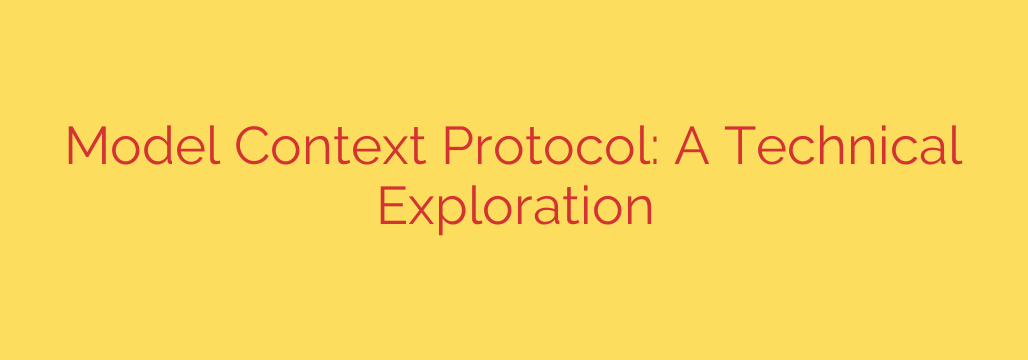
Beyond RAG: Why the Model Context Protocol is a Game-Changer for AI Privacy
Artificial intelligence is transforming how we work, analyze data, and generate new ideas. From drafting emails to dissecting complex financial reports, AI models are becoming indispensable business partners. But as we increasingly rely on these tools, a critical question emerges: Is our sensitive data safe?
When you ask an AI to summarize a confidential document or analyze private customer data, you’re often sending that information directly to a third-party server. This common practice, known as Retrieval-Augmented Generation (RAG), creates a significant security vulnerability. A new approach, the Model Context Protocol (MCP), offers a powerful solution to protect your data while unlocking the full potential of AI.
The Hidden Risk in Today’s AI: The Problem with RAG
Retrieval-Augmented Generation (RAG) is the standard method for giving large language models (LLMs) access to information that wasn’t in their original training data. In simple terms, you find relevant documents and paste their content into the prompt alongside your question. The AI then uses this “context” to generate a specific, informed answer.
While effective, this method has a fundamental flaw. To provide that context, you are transmitting your raw, unencrypted data to the AI provider.
This is the digital equivalent of handing over your company’s entire filing cabinet to an outside consultant just to have them look at a single page. Standard RAG models expose your sensitive data directly to the AI provider, creating risks of data leaks, privacy breaches, and unauthorized access. For businesses in finance, healthcare, or law, this level of exposure is simply unacceptable.
A New Paradigm for AI Security: Introducing the Model Context Protocol (MCP)
The Model Context Protocol (MCP) is a groundbreaking set of rules designed to solve the inherent security issues of RAG. Instead of sending the actual data to the AI model, MCP allows the model to work with the data in a completely secure and private way.
The core idea is simple yet revolutionary: you provide the model with a reference or a pointer to your data, not the data itself. The protocol then uses this reference to perform computations on the data inside a locked, encrypted digital vault.
Think of it as giving a trusted analyst a key to a specific safe deposit box, which they can only open inside a secure bank vault. They can perform their analysis inside the vault and give you the results, but they can never walk out with the contents of the box. MCP allows an AI to use your data without the AI provider ever “seeing” it in a raw, unencrypted state.
How the Model Context Protocol Works
MCP leverages a technology known as confidential computing, which uses hardware-based Trusted Execution Environments (TEEs). A TEE is an isolated, secure area of a processor that encrypts data while it’s being used, protecting it from the rest of the system—including the server’s owner.
The process is a major leap forward for data security:
- Reference, Don’t Send: The user provides the AI with a secure pointer (a reference) to the location of the confidential data (e.g., a specific file in their cloud storage).
- Secure Fetch: The MCP fetches the data and loads it directly into a TEE, a secure and encrypted enclave on the server.
- Confidential Computation: The AI model performs its analysis—summarizing, translating, or answering questions—entirely within this protected environment. The data remains encrypted and inaccessible to the host system at all times.
- Secure Output: The model generates its response based on the confidential context and delivers the final result to the user. The sensitive source data is never exposed or logged by the AI provider.
The Key Advantages of Adopting MCP
Implementing a protocol like MCP isn’t just an incremental improvement; it’s a fundamental shift in how we approach AI security.
- Unprecedented Data Security: By processing data within a TEE, MCP virtually eliminates the risk of data exposure to the AI provider. Your trade secrets, financial records, and personal information remain truly private.
- Enhanced User Control: You maintain sovereignty over your data. Access is granted on a need-to-know basis for a specific task, and you never have to hand over raw files.
- Unlocking New AI Applications: MCP opens the door for AI to be used in highly regulated industries. Hospitals can use AI to analyze patient records, and law firms can analyze sensitive case files without breaching confidentiality.
- Improved Efficiency: Sending massive blocks of text in a prompt is inefficient and can quickly exhaust an AI’s context window. MCP is a more streamlined and scalable method for providing large amounts of context.
Actionable Security Tips for Your Business
As AI continues to evolve, security can no longer be an afterthought. The principles behind the Model Context Protocol offer a clear roadmap for safely integrating AI into your operations.
- Vet Your AI Vendors: Before adopting any AI tool, ask direct questions about their data handling policies. Inquire if they use confidential computing, TEEs, or a similar protocol to protect user data during processing.
- Prioritize “Zero-Trust” Solutions: Look for AI platforms that operate on a zero-trust principle, meaning they are architected so that not even the provider can access customer data.
- Educate Your Team: Ensure every employee understands the danger of pasting sensitive information into public AI chatbots or tools that lack robust security guarantees.
- Advocate for Secure Standards: The future of AI depends on trust. Support and adopt technologies and protocols that prioritize user privacy and data security by design.
The road to a truly intelligent future is paved with trust. Protocols like MCP are essential building blocks, ensuring that we can harness the incredible power of artificial intelligence without sacrificing the privacy and security that our data deserves.
Source: https://collabnix.com/what-is-model-context-protocol-a-technical-deep-dive/








